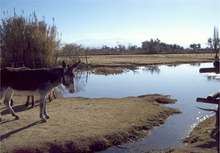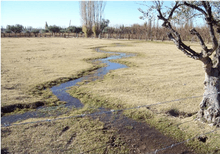Galba neotropica
Galba neotropica is a species of air-breathing freshwater snail, an aquatic pulmonate gastropod mollusk in the family Lymnaeidae, the pond snails.
| Galba neotropica | |
|---|---|
| Scientific classification | |
| Kingdom: | |
| Phylum: | |
| Class: | |
| (unranked): | |
| Superfamily: | |
| Family: | |
| Subfamily: | Lymnaeinae |
| Genus: | |
| Species: | G. neotropica |
| Binomial name | |
| Galba neotropica (Bargues, Artigas, Mera y Sierra, Pointier & Mas-Coma, 2007)[1] | |
| Synonyms[2] | |
|
Lymnaea neotropica Bargues, Artigas, Mera y Sierra, Pointier & Mas-Coma, 2007 | |
This species was described as Lymnaea neotropica in 2007.[1] However, it belongs to the Galba/Fossaria group,[1][3] therefore this species is named Galba neotropica. cf.[2][3][4]
Galba neotropica is the vector typically responsible for fascioliasis (liver fluke) livestock infection.[5]
Distribution
Galba neotropica was originally described from Lima, Peru and surroundings;[1] it appears to be a species restricted to South America, but with a very broad geographical distribution from Argentina in the Southern Cone north to Venezuela.[5]
The distribution of this species includes:
Description
The maximum length of the shell of this species is 10.36 mm.[5] Whorls are convex.[5] The columella is slightly curved and unfolded.[5]
An examination of tentacles, eyes and colour in living specimens has never performed.[5]
In the radula, the first bilateral teeth are bicuspid but occasionally they are tricuspid or rarely quadricuspid.[5] The praeputium/penis sheath length ratio is 1.10-3.90 mm (mean 2.12-2.70 mm).[5]
Two species that have a similar morphology are Galba truncatula and Galba schirazensis.[5] Although several phenotypic characteristics are somewhat helpful for a preliminary specimen classification, a definitive classification of a specimen can only be obtained by the sequencing of at least one of the molecular markers used: ITS-2, ITS-1, 16S and cox1.[5]
Ecology
Galba neotropica is sometimes amphibious.[5] The habitat of Galba neotropica rarely[5] also includes artificial water bodies.[7]
 An artificial pond in Mendoza Province, Argentina |
 An artificial irrigation channel, Mendoza Province, Argentina |
These snails hatch from eggs. The shape of the egg cluster is rounded to oval when containing few eggs; when the clutch includes more eggs there is lengthening with a slight curving trend.[5] There are about 4-16 eggs in each cluster.[5]
Parasites of Galba neotropica include:
- Fasciola hepatica.[6] The transmission capacity of Fasciola hepatica to humans is low, however, the transmission capacity of Fasciola hepatica to animals is high.[5]
References
This article incorporates CC-BY-2.0 text from the reference[5]
- Bargues, M.; Artigas, P.; Mera y Sierra, R. L.; Pointier, J. P.; Mas-Coma, S. (2007). "Characterisation of Lymnaea cubensis, L. Viatrix and L. Neotropica n. Sp., the main vectors of Fasciola hepatica in Latin America, by analysis of their ribosomal and mitochondrial DNA". Annals of Tropical Medicine and Parasitology. 101 (7): 621–41. doi:10.1179/136485907X229077. PMID 17877881..
- "Galba neotropica". Taxonomy browser, accessed 19 September 2012.
- Bargues, María Dolores; Artigas, Patricio; Khoubbane, Messaoud; Flores, Rosmary; Glöer, Peter; Rojas-García, Raúl; Ashrafi, Keyhan; Falkner, Gerhard; Mas-Coma, Santiago (2011). Braga, Erika Martins (ed.). "Lymnaea schirazensis, an Overlooked Snail Distorting Fascioliasis Data: Genotype, Phenotype, Ecology, Worldwide Spread, Susceptibility, Applicability". PLoS ONE. 6 (9): e24567. doi:10.1371/journal.pone.0024567. PMC 3183092. PMID 21980347..
- Correa, Ana C; Escobar, Juan S; Durand, Patrick; Renaud, François; David, Patrice; Jarne, Philippe; Pointier, Jean-Pierre; Hurtrez-Boussès, Sylvie (2010). "Bridging gaps in the molecular phylogeny of the Lymnaeidae (Gastropoda: Pulmonata), vectors of Fascioliasis". BMC Evolutionary Biology. 10: 381. doi:10.1186/1471-2148-10-381. PMC 3013105. PMID 21143890.
- Bargues, M; Artigas, Patricio; Khoubbane, Messaoud; Ortiz, Pedro; Naquira, Cesar; Mas-Coma, Santiago (2012). "Molecular characterisation of Galba truncatula, Lymnaea neotropica and L. Schirazensis from Cajamarca, Peru and their potential role in transmission of human and animal fascioliasis". Parasites & Vectors. 5: 174. doi:10.1186/1756-3305-5-174. PMC 3436774., table 2.
- Mera y Sierra, Roberto; Artigas, Patricio; Cuervo, Pablo; Deis, Erika; Sidoti, Laura; Mas-Coma, Santiago; Bargues, Maria Dolores (2009). "Fascioliasis transmission by Lymnaea neotropica confirmed by nuclear rDNA and mtDNA sequencing in Argentina". Veterinary Parasitology. 166 (1–2): 73–9. doi:10.1016/j.vetpar.2009.08.001. PMID 19729246..
- Mera y Sierra, Roberto; Agramunt, Veronica H; Cuervo, Pablo; Mas-Coma, Santiago (2011). "Human fascioliasis in Argentina: Retrospective overview, critical analysis and baseline for future research". Parasites & Vectors. 4: 104. doi:10.1186/1756-3305-4-104. PMC 3141741.